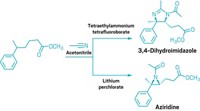Advertisement
Grab your lab coat. Let's get started
Welcome!
Welcome!
Create an account below to get 6 C&EN articles per month, receive newsletters and more - all free.
It seems this is your first time logging in online. Please enter the following information to continue.
As an ACS member you automatically get access to this site. All we need is few more details to create your reading experience.
Not you? Sign in with a different account.
Not you? Sign in with a different account.
ERROR 1
ERROR 1
ERROR 2
ERROR 2
ERROR 2
ERROR 2
ERROR 2
Password and Confirm password must match.
If you have an ACS member number, please enter it here so we can link this account to your membership. (optional)
ERROR 2
ACS values your privacy. By submitting your information, you are gaining access to C&EN and subscribing to our weekly newsletter. We use the information you provide to make your reading experience better, and we will never sell your data to third party members.
Catalysis
Road to chiral alkylamines paved with iridium
Cationic catalyst adds amines to internal alkenes
by Leigh Krietsch Boerner
November 11, 2020
| A version of this story appeared in
Volume 98, Issue 44

Alkylamines are one of the most useful compounds in a chemist’s bag of tricks. Pharmaceuticals, agrochemicals, and polymers often contain these functional groups. Ideally, chemists would like to make alkylamines from widely available feedstocks, but the existing methods for doing so don’t excel at reacting with internal alkenes. John Hartwig and coworkers at the University of California, Berkeley, have now figured out how.
The group used a positively charged iridium catalyst and an amine to add an NH bond to an internal alkene. This generates chiral alkylamines with high regioselectivity and moderate to high yields (Nature, 2020, DOI: 10.1038/s41586-020-2919-z).
Researchers have tried to make similar compounds in the past but have not been able to get good yields of the desired chiral products. The key to Hartwig’s synthesis was choosing bidentate aminopyridine derivatives both as ligands and reactants, which helps control the chirality of the product while preventing unwanted side reactions. During the reaction, two aminopyridine molecules bind to the Ir center. One is displaced by the incoming alkene while the other remains on the catalyst. The researchers think this configuration locks the geometry so the alkene can only add from one side of the catalyst molecule. The amine group on the aminopyridine helps to block unwanted side reactions, leading to chiral alkylamines with regioselectivity near 100% in some cases. The pyridine moiety can then be removed to give the final amine.
The cationic Ir catalyst also speeds up the reductive elimination step to release the alkylamine, which “leads to addition faster than isomerization,” Hartwig says. The team hopes that this new synthesis will lead to adding O–H and C–H groups in the same way.
The ultimate goal is to use ammonia as the amine source, but the researchers started out with the aminopyridine as a stand-in. “This approach is promising because it not only tunes the catalyst but includes an ammonia surrogate,” says Vy Dong, an organic chemist at the University of California, Irvine. “It highlights the power of designing reagents and using mechanistic insights to achieve otherwise impossible reactivity.”




Join the conversation
Contact the reporter
Submit a Letter to the Editor for publication
Engage with us on Twitter